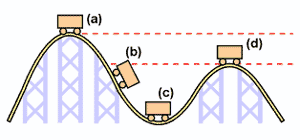I thought I understand electricity but some thing don't add up so I'm hoping someone can tell me what I am doing wrong. So, to me, voltage represents a potential ability/energy of a charge to do some work/to transfer energy. Resistor uses some of that energy to heat itself or do something else (doesn't matter what really), in order to drop the voltage of the charge. By dropping voltage, it also reduces the current (because the charge is now 'less needy' to get to the other terminal). With this understanding of electricity, I tried to understand the following circuit:

simulate this circuit – Schematic created using CircuitLab
The Voltage source is 3V. The current is easily calculated as 1A.
So the story goes: Source is giving 1 amper of current an 'ability' of 3 volts. The first resistor causes a 2V voltage drop. Now that amper has only 1 volt of 'ability' left. The current reaches the branch. It divides equally, 0.5A goes to each branch. But the resistance of the resistors in parallel branches is 2 ohms, and I only have 1V left per ampere! Not only that, but my current that passes through the resistor is not even 1A anymore, now it's only 0.5A, which means it has only 0.5V of 'ability' left! So what's going on here?
A side question that arises: By Kirchhoffs laws, the sum of voltage drops has to equal the voltage of the source. So in the end, the voltage of a charge is 0 (after it passes thorough the last resistor). Why does it even move then, if it's 'willingness' to get to the other terminal is now 0?


